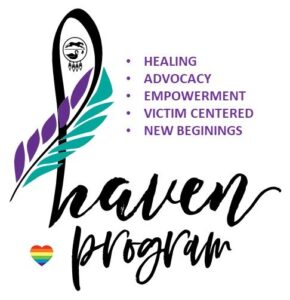H.A.V.E.N. Update
By Cathleen Osborne-Gowey (Program Admin – Crime Victim Advocate) 918.554.2836 or COsbornegowey@estoo.net
Upcoming Events:
Support Group will now be IN PERSON: Please call our office for details.
Program Update:
Hello all –
Winter is here – temperatures have dropped – and the holiday season has passed. This month we’re focusing our article on what are the signs of domestic violence. Often – violence comes on quietly and slowly –sometimes we don’t recognize it’s beginning. Below is an article, found at psychcentral, detailing how to recognize the signs of domestic violence.
Signs of Domestic Violence
(What are the Signs of Domestic Violence at https://psychcentral.com/lib/symptoms-of-domestic-violence#characteristics)
Recognizing domestic violence can be challenging — but there are signs to look out for. Domestic violence can come in many forms. It could involve sexual abuse, financial abuse, or the often-subtle emotional abuse.
It can affect anyone regardless of age, gender, or race. The National Coalition Against Domestic Violence estimates that more than 10 million people — men and women — are affected by domestic violence each year.
Not every situation will look the same, making it difficult to recognize. If you’re in a domestic violence situation, understanding the most common signs of domestic violence can help you navigate this situation.
What is domestic violence?
While the term “domestic violence” often refers to intimate partner violence, it could also include elder abuse, child abuse, and any other kind of abuse within a home or family unit.
The abuse could be psychological, emotional, financial, physical, or sexual.
Physical abuse
Physical abuse includes directly hurting someone physically. It could also include threats to hurt you or your children, pets, or loved ones.
Sexual abuse
Sexual abuse refers to any type of sexual-related abuse, including sexual violence and assault.
This type of abuse could also include patterns of sexual coercion — for example, you might be manipulated into sexual activity by a partner who threatens to hurt you.
It’s important to note that elder abuse could also encompass sexual abuse.
Emotional abuse
Emotional abuse isn’t always easy to recognize — it can be subtle and covert. It can come in the form of actions or words from anyone, even a boss or co-worker.
Two of the most common forms of emotional abuse are gaslighting and projection.
It could include:
- attempts to control you and your behavior
- humiliating you
- insulting or belittling you
- putting down your interests, career, and/or relationships
- manipulating you through emotional blackmail or guilt-tripping you
- blaming you for their issues
- accusing you of cheating or not loving them
- outbursts, especially when you don’t do what they want
- isolating you from loved ones
Emotional abuse could also be a component of other forms of abuse.
Financial abuse
Financial abuse includes restricting a person’s access to their own money. You might be forced to depend on the person who’s abusing you for financial needs.
This often makes it difficult to leave a violent situation.
What are the signs of domestic violence?
The symptoms of domestic violence vary depending on the type of abuse. While some types of abuse leave visible scars and bruises, others do not.
Physical signs of domestic abuse
A person being physically abused might have frequent injuries and bruises.
Signs of physical abuse could include:
- black eyes
- bruises on the arms, limbs, or neck
- sprained wrists
- broken bones
- unexplained pain
A person who is being physically abused might be unable to explain what caused their injuries, or their explanations might seem shaky and inconsistent.
They might attempt to cover up their injuries by wearing heavy makeup or more clothing than usual such as a scarf or long-sleeved shirt when it’s hot.
They might also cancel events or avoid seeing people until their injuries heal.
Emotional signs of domestic abuse
All types of domestic abuse could impact a person emotionally.
If a person is in a domestic violence situation, you might notice changes in their behavior, such as:
- increased levels of anxiety
- increased levels of irritability and anger
- low self-esteem
- seeming more fearful, including flinching at sudden movements or sounds
- lack of interest in usual hobbies or activities
- fatigue and lack of energy
- increased crying
- seeming more sad, tearful, or numb
- suicidal ideation
These symptoms don’t necessarily prove that someone is being abused. There could be another explanation, including a recent trauma or loss.
Behavioral signs of domestic abuse
As a result of the abuse, a person’s behavior might change. This could include:
- sleeping too much or too little
- change in appetite
- using substances, such as drugs and alcohol, more often
- isolating themselves from loved ones
- withdrawing from social events
- avoiding activities/events they usually enjoy
Not every domestic abuse survivor will display these symptoms. There’s no one way to feel or act after abuse, and everybody reacts differently.
If you have concerns about what’s happening in your relationship, we’re here to listen and support you!
If you are able please call or see the messaging links above:
Haven Office: 918-554-2836 Text Line: 918.533.3070
Program Website: https://havenprogram.com/
Program Email: havenprogram@estoo.net
Facebook: HAVEN Tribal Program, Twitter: @ProgramHaven, Instagram: HAVENTRIBALProgram.





